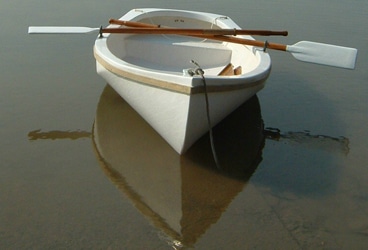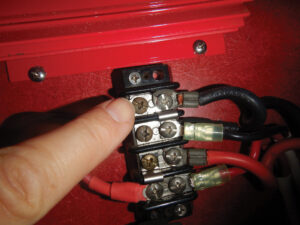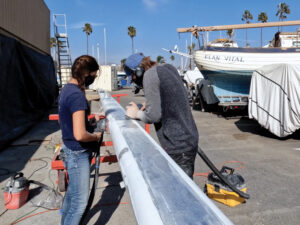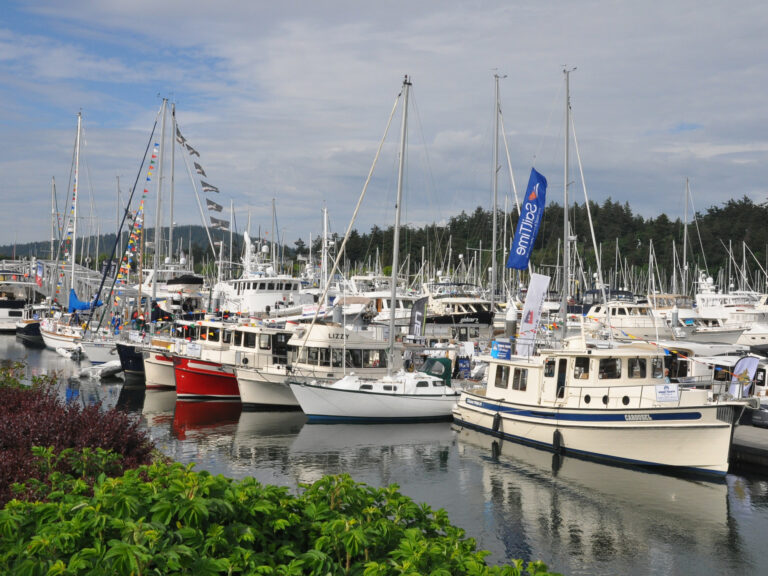
Zartman- dinghy
When Ganymede launched, three years after construction began, and six long years after we had moved ashore to start the boatbuilding process, I had felt like never building a boat ever again. After all, I had built 15 or so dinghies, as well as the molds for them all, and used up several 55 gallon drums of polyester resin in putting decks, cabin, bulkheads and rudder on Ganymede. My memory of that time is mostly of endless grinding, sanding, itching, and sanding some more. There was also lots of sticky stuff, and plenty of terrible smell. Everything related to boatbuilding, from melting lead for ballast to browsing catalogs for parts and equipment, had lost its lustre. It was time to go cruising, and it felt great to not have to get into acetone any more, or mix paint or apply varnish.
I hadn’t really wanted to get back into boatbuilding when we returned to Rhode Island for the winter, but it seems that one of the main things going on here in the winter is boatbuilding and repair, and all my friends who were in a position to recommend jobs are boatbuilders as well. Well, it had been a while, anyway, since I had bathed in acetone, so I took a place at a fiberglass shop that builds the Vanquish speedboats—high-end semi-custom 26-foot runabouts.
My particular job was to be building a plug for a redesigned deck mold. For my readers who aren’t conversant in fiberglass-ish, a plug is a full-sized prototype of the object you want to make, from which molds are made to make the final product in. Sounds complicated, and it rather is. First we made a sacrificial deck to modify, and I spent a few days laboriously cutting various bits of it away with a sawzall. Then we had to build the new interior into it with MDF—a cheap sort or pressed board that works easily and doesn’t warp or move. For several weeks we built shapes—settees, consoles, bulkheads—screwed them, glued them and installed them. After that we either chiselled them back out for newly-invented modifications, or after spending several days making nice fillets all around with Bondo, had to put in an addition that completely covered the fillets anyway, and had to be filleted in turn.

It was just like old times dinghy building, really: fairing compound on, sand off, apply again, but on a much larger scale. Before the plug was ready for primer, we had mostly sanded off, by hand, fifteen gallons of fairing putty. The shop, usually pretty messy anyway, was thick with MDF dust, Bondo dust, and curled bits of spent sandpaper. I had hoped to learn perhaps a few labor-saving tricks that I hadn’t known when I was working on my own, but it looks like the only shortcut to plug-building is to make everything very carefully so as not to have to fair it too much.
It was a big day when the plug was finally deemed ready for the last coat of primer. None of us had fingerprints left—the pads of our fingers had all been sanded off. It looked pretty sleek, gleaming black and looking miraculously perfect. It looked done, in fact, and in a way it is. All we have to do now, all we’ll do for the next two weeks or so, is to sand some more, around and around with ever finer grits of paper, till the whole shebang is mirror smooth and ready to wax. It seems strange that only a few days after all these months of labor are poured into this thing, as soon as the mold comes off it, in fact, we’re going to have to cut it up and toss it in the dumpster. In a way I’m glad, since we’re pretty sick of the old thing by now, but at the same time it seems a shame to toss it out after all that work. And unless I miss my guess, the person who’s worked on it the most, the person who was hired specifically to help with this, will be the one who has to chop it up.
Ah well, it’ll be just like old times, and after a four-year break from it all, it’s not so bad to be building boats again.








